Modeling the Impact of Climate Change on Streamflow in the Meghna River Basin: An Analysis Using SWAT and CMIP6 Scenarios
Abstract
1. Introduction
2. Materials and Methods
2.1. Study Area
2.2. Data
2.2.1. Elevation, Soil and Land Use Data
2.2.2. Climate Data and Hydrological Data
2.3. Methodology: The SWAT Model
2.3.1. Model Background
2.3.2. Model Setup
2.3.3. Calibration Strategies
2.3.4. Model Performance and Sensitivity Analysis
2.3.5. Future Flow Simulation
3. Results
3.1. Results from SWAT Model Calibration and Sensitivity Analysis
3.2. Climate Change Impact on Flow Availability
3.2.1. Changes in Annual Maximum Flow
3.2.2. Changes in Monthly Mean Flow
3.2.3. Changes in Design Flow at Different Return Periods
4. Discussion
5. Conclusions
Author Contributions
Funding
Data Availability Statement
Conflicts of Interest
Appendix A
| Attributes | Meghalaya | Barak | Tripura |
|---|---|---|---|
| Area | 7642 km2 | 28,074 km2 | 10,895 km2 |
| Location | Northeastern India | Nagaland, Assam, Mizoram, Manipur | Eastern India |
| Precipitation | 2605–2878 mm (2311 mm) | 1682–1817 mm (1749 mm) | 2207–2415 mm (2311 mm) |
| Elevation Range | 7–1890 m | 11–1931 m | 3–472 m |
| Slope Distribution | majority > 35% | majority > 35% | majority 10–35% |
| Dominant Soil group | Ao75-2b-3647, Ao78-3c-3649, Ao74-2b-3646 | Bh16-2-3c-4301, Bd61-2c-3665 | Bd61-2c-3665, Ge51-2a-3707 |
| Dominant LULC | Grass-ranges (~50%) along with Forests (25–40%) | Grass-ranges (~50%) along with Forests (25–40%) | Agricultural lands and Grass-ranges (42%, 31%) |
| Parameter Name * | Description | Initial Value Range ** |
|---|---|---|
| R_CN2.mgt | SCS runoff curve number for antecedent moisture condition II | −0.2 to 0.2 |
| V_ALPHA_BF.gw | Base flow alpha-factor (1/days) | 0.0 to 1.0 |
| V_GW_DELAY.gw | Groundwater delay (days) | 30.0 to 450.0 |
| V_GWQMN.gw | Threshold depth of water in the shallow aquifer required for return flow to occur (mm water) | 0.0 to 2.0 |
| V_GW_REVAP.gw | Groundwater ‘revap’ coefficient | 0.0 to 0.2 |
| R_SOL_AWC.sol | Available water capacity of the soil layer (mm water/ mm soil) | −0.2 to 0.4 |
| R_SOL_K.sol | Saturated hydraulic conductivity (mm/hr) | −0.8 to 0.8 |
| R_SOL_BD.sol | Moist bulk density (gm/cm3) | −0.5 to 0.6 |
| A_ESCO.hru | Soil evaporation compensation factor | 0.0 to 0.2 |
| R_EPCO.hru | Plant uptake compensation factor | 0.0 to 0.5 |
| R_HRU_SLP.hru | Average slope steepness (m/m) | 0.0 to 0.2 |
| R_OV_N.hru | Manning’s ‘n’ value for overland flow | −0.2 to 0.0 |
| R_SLSUBBSN.hru | Average slope length (m) | 0.0 to 0.2 |
| V_CH_N(2).rte | Manning’s ‘n’ value for the main channel | 0.0 to 0.3 |
| V_CH_K(2).rte | Effective hydraulic conductivity in main channel alluvium (mm/hr) | 0.0 to 130.0 |
| Sub-basins and Model Name | Sensitive Parameter | p-Value | t-Test | Fitted Value |
|---|---|---|---|---|
| Barak-01 | R_CN2.mgt | 0.00003 | −4.3927 | −0.13811 |
| R_SOL_BD | 0.00057 | −3.5796 | −0.16450 | |
| V_ALPHA_BF.gw | 0.03779 | 2.11042 | 0.42501 | |
| R_SOL_K.sol ** | 0.05329 | −1.9602 | 0.66410 | |
| A_ESCO.hru ** | 0.06617 | −1.8615 | 0.03704 | |
| Tripura-01 | R_CN2.mgt | 0.00011 | −8.91387 | −0.09568 |
| A_ESCO.hru ** | 0.05257 | −1.96624 | −0.05913 | |
| R_HRU_SLP.hru ** | 0.06150 | −1.82535 | 0.10764 | |
| Meghalaya-02 | R_CN2.mgt | 0.00008 | −8.69546 | −0.26041 |
| R_SOL_BD.sol | 0.00014 | −3.99517 | −0.63703 | |
| R_HRU_SLP.hru | 0.00115 | −3.36752 | 0.07218 | |
| R_SOL_K.sol | 0.01231 | −2.55825 | −0.41086 | |
| V_CH_K(2).rte | 0.01609 | 2.45633 | 81.8464 | |
| V_GW_DELAY.gw ** | 0.05746 | −1.92624 | 65.4086 |
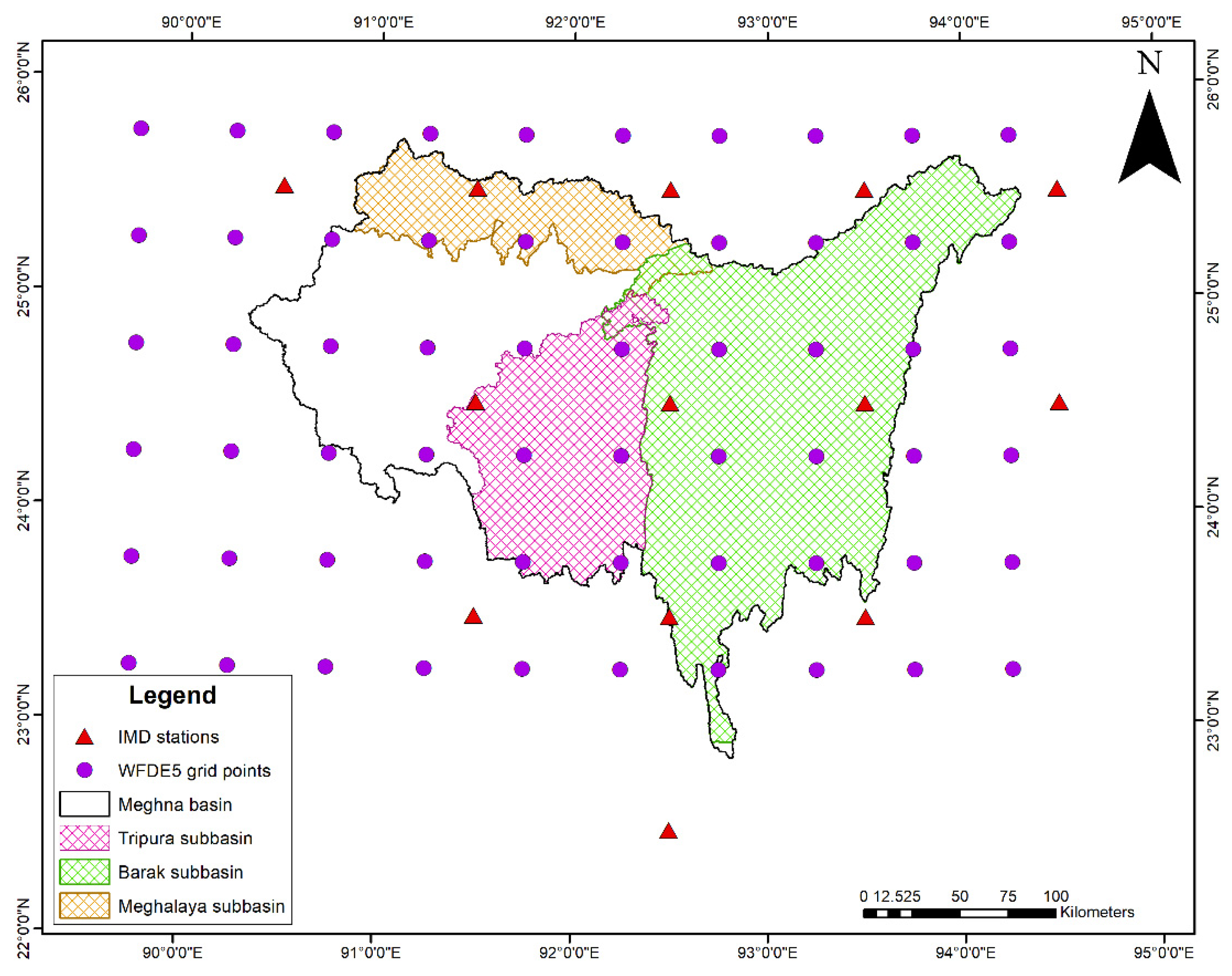
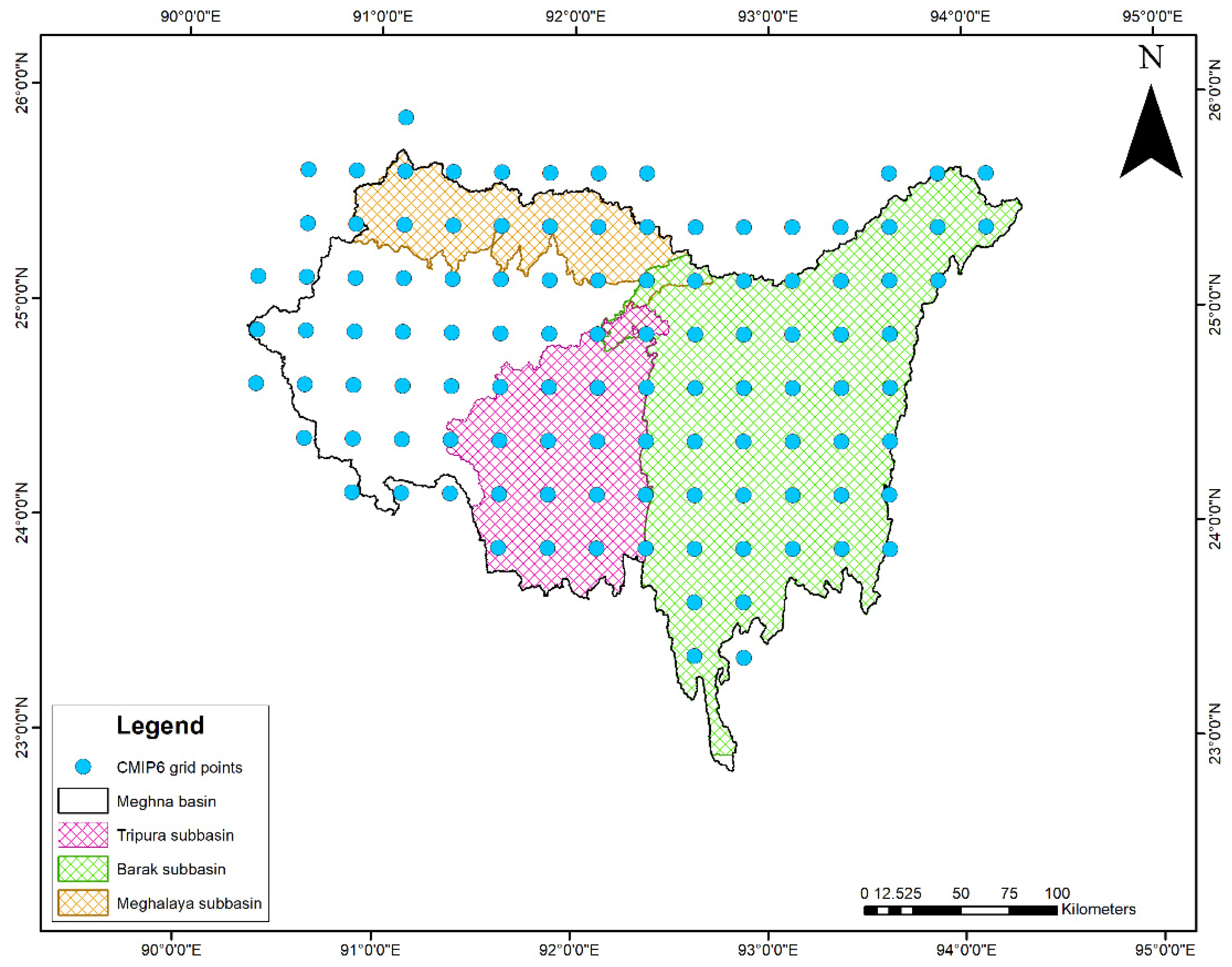
References
- Kundu, A.; Dwivedi, S.; Chandra, V. Precipitation Trend Analysis over Eastern Region of India Using Cmip5 Based Climatic Models. ISPRS—International Archives of the Photogrammetry. Remote Sens. Spat. Inf. Sci. 2014, 8, 1437–1442. [Google Scholar]
- Khaing, M. Multi-Model Analysis of the Climate Change Impact and Adaptation of Hydropower Generation in the Myitnge River Basin. Master’s Thesis, Asian Institute of Technology, School of Engineering and Technology, Khlong Nueng, Thailand, 2014. [Google Scholar]
- Mirza, M.M.Q.; Warrick, R.A.; Ericksen, N.J. The implications of climate change on floods of the Ganges, Brahmaputra and Meghna rivers in Bangladesh. Clim. Chang. 2003, 57, 287–318. [Google Scholar] [CrossRef]
- Mirza, M.Q.; Dixit, A. Climate Change and Water Management in The GBM Basins. Water Nepal 1997, 5, 71–100. [Google Scholar]
- Rangachari, R.; Verghese, B.G. Making water work to translate poverty into prosperity: The Ganga-Brahmaputra-Barak region. In Ganges–Brahmaputra–Meghna Region: A Framework for Sustainable Development; University Press Ltd.: Dhaka, Bangladesh, 2001; pp. 81–142. [Google Scholar]
- Masood, M.; Takeuchi, K. Climate change impact on the manageability of floods and droughts of the Ganges-Brahmaputra-Meghna basins using Flood Duration Curves and Drought Duration Curves. J. Disaster Res. 2015, 10, 991–1000. [Google Scholar] [CrossRef]
- Oki, T.; Kanae, S. Global hydrological cycles and world water resources. Science 2006, 313, 1068–1072. [Google Scholar] [CrossRef] [PubMed]
- Arnell, N.W. Climate change and global water resources. Glob. Environ. Chang. 1999, 9, S31–S49. [Google Scholar] [CrossRef]
- Chalov, S.R.; Kasimov, N.S.; Romanchenko, A.O.; Pietron, J.; Thorslund, J.; Promakhova, E.V. Spatio-temporal variation of sediment transport in the Selenga River Basin, Mongolia and Russia. Environ. Earth Sci. 2015, 73, 663–680. [Google Scholar] [CrossRef]
- Pechlivanidis, I.G.; Donnelly, C.; Huang, S.; Aich, V.; Samaniego, L.; Eisner, S.; Shi, P. Analysis of hydrological extremes at different hydro-climatic regimes under present and future conditions. Clim. Chang. 2015, 141, 467–481. [Google Scholar] [CrossRef]
- Uhe, P.F.; Mitchell, D.M.; Bates, P.D.; Sampson, C.C.; Smith, A.M.; Islam, A.K.M.S. Enhanced flood risk with 1.5 °C global warming in the Ganges–Brahmaputra–Meghna basin. Environ. Res. Lett. 2019, 14, 074031. [Google Scholar] [CrossRef]
- Mirza, M.Q. Global warming and changes in the probability of occurrence of floods in Bangladesh and implications. Glob. Environ. Chang. 2002, 12, 127–138. [Google Scholar] [CrossRef]
- Immerzeel, W.W.; Van Beek, L.P.; Bierkens, M.F. Climate change will affect the Asian water towers. Science 2010, 328, 1382–1385. [Google Scholar] [CrossRef] [PubMed]
- Mohammed, K. Comparative Study of Performance for Real-Time Flash Flood Forecasting in the Upper Meghna Basin. Master’s Thesis, Institute of Water and Flood Management, Bangladesh University of Engineering and Technology (BUET), Dhaka, Bangladesh, 2017. [Google Scholar]
- Nishat, A.; Faisal, I.M. An assessment of the Institutional Mechanism for Water Negotiations in the Ganges–Brahmaputra–Meghna system. Int. Negot. 2000, 5, 289–310. [Google Scholar] [CrossRef]
- Salehin, M.; Chowdhury, J.U.; Islam, A.K.M.S. Development of a Water Resources Model as a Decision Support Tool for National Water Management; Technical Report; Institute of Water and Flood Management, BUET: Dhaka, Bangladesh, 2011. [Google Scholar]
- Hassan, A.; Wahid, S.; Shrestha, M.L.; Rashid, M.A.; Ahmed, T.; Mazumder, A.; Sarker, M.H.; Hossain, B.M.T.H.; Mumu, S.; Sarker, M.H. Climate Change and Water Availability in the Ganges-BrahmaputraMeghna Basin: Impact on Local Crop Production and Policy Directives. In Research Insights on Climate and Water in the Hindu Kush Himalayas; ICIMOD: Kathmandu, Nepal, 2014; p. 97. [Google Scholar]
- Islam, M.A.; Islam, S.L.; Hassan, A. Impact of Climate Change on Water with Reference to the Ganges-Brahmaputra-Meghna River Basin. In Chemistry and Water; Elsevier: Amsterdam, The Netherlands, 2017; pp. 121–160. [Google Scholar]
- Anand, J.; Gosain, A.K.; Khosa, R.; Srinivasan, R. Regional scale hydrologic modeling for prediction of water balance, analysis of trends in streamflow and variations in streamflow: The case study of the Ganga River basin. J. Hydrol. Reg. Stud. 2018, 16, 32–53. [Google Scholar] [CrossRef]
- Mohammed, K.; Islam, A.S.; Islam, G.M.T.; Alferi, L.; Bala, S.K.; Khan, M.J.U. Future floods in Bangladesh under 1.5 °C, 2 °C and 4 °C global warming scenarios. J. Hydrol. Eng. 2018, 23, 04018050. [Google Scholar] [CrossRef]
- Mondal, M.S.; Islam, A.S.; Haque, A.; Islam, A.; Biswas, S.; Mohammed, K. Assessing high-end climate change impacts on floods in major rivers of Bangladesh using multi-model simulations. Glob. Sci. Technol. J. 2018, 6, 1–14. [Google Scholar]
- Alam, S.; Ali, M.; Rahaman, A.Z.; Islam, Z. Multi-model ensemble projection of mean and extreme streamflow of Brahmaputra River Basin under the impact of climate change. J. Water Clim. Chang. 2021, 12, 2026–2044. [Google Scholar] [CrossRef]
- Alam, Z.R.; Rahman, M.M.; Islam, A.K.M.S. Assessment of Climate Change Impact on the Meghna River Basin using Geomorphology Based Hydrological Model (GBHM). In Proceedings of the 3rd International Conference on Water & Flood Management, Dhaka, Bangladesh, 8–10 January 2011. [Google Scholar]
- Ali, M.M.; Narzis, A.; Haque, S. Evaluation of Climate Change Scenarios of Upper Meghna River Basin using Hydrologic Modeling system (HEC-HMS). In Proceedings of the 2nd International Conference on Advances in Civil Engineering 2014 (ICACE), Chittagong, Bangladesh, 26–28 December 2014; Volume 3, pp. 54–63. [Google Scholar]
- Al Hossain, B.M.T.; Ahmed, T.; Aktar, M.N.; Fida, M.; Khan, A.; Islam, A.S.; Rahaman, A.Z. Climate Change Impacts on Water Availability in the Meghna Basin. In Proceedings of the 5th International Conference on Water & Flood Management, Dhaka, Bangladesh, 6–8 March 2015; pp. 6–8. [Google Scholar]
- Narzis, A. Impacts of Climate Change and Upstream Intervention on the Hydrology of the Meghna River Basin Using SWAT. Master’s Thesis, Department of Water Resources Engineering, Bangladesh University of Engineering and Technology (BUET), Dhaka, Bangladesh, 2020. [Google Scholar]
- Rahman, M.M.; Thompson, J.R.; Flower, R.J. Hydrological impacts of climate change on rice cultivated riparian wetlands in the Upper Meghna River Basin (Bangladesh and India). Hydrol. Sci. J. 2019, 65, 33–56. [Google Scholar] [CrossRef]
- Krysanova, V.; Hattermann, F.; Wechsung, F. Development of the ecohydrological model SWIM for regional impact studies and vulnerability assessment. Hydrol. Process. Int. J. 2005, 19, 763–783. [Google Scholar] [CrossRef]
- Qi, C.; Grunwald, S. GIS-based hydrologic modeling in the Sandusky watershed using SWAT. Trans. ASAE 2005, 48, 169–180. [Google Scholar] [CrossRef]
- Hattermann, F.F.; Krysanova, V.; Gosling, S.N.; Dankers, R.; Daggupati, P.; Donnelly, C.; Flörke, M.; Huang, S.; Motovilov, Y.; Buda, S.; et al. Cross-scale intercomparison of climate change impacts simulated by regional and global hydrological models in eleven large river basins. Clim. Chang. 2016, 141, 561–576. [Google Scholar] [CrossRef]
- Gosling, S.N.; Zaherpour, J.; Mount, N.J.; Hattermann, F.; Dankers, R.; Arheimer, B.; Breuer, L.; Ding Haddeland, I.; Kumar, R.; Kundu, D.; et al. A comparison of changes in river runoff from multiple global and catchment-scale hydrological models under global warming scenarios of 1 °C, 2 °C and 3 °C. Clim. Chang. 2017, 141, 577–595. [Google Scholar] [CrossRef]
- Daggupati, P.; Yen, H.; White, M.J.; Srinivasan, R.; Arnold, J.G.; Keitzer, C.S.; Sowa, S.P. Impact of model development, calibration and validation decisions on hydrological simulations in West Lake Erie Basin. Hydrol. Process. 2015, 29, 5307–5320. [Google Scholar] [CrossRef]
- Masood, M.; Yeh, P.F.; Hanasaki, N.; Takeuchi, K. Model study of the impacts of future climate change on the hydrology of Ganges–Brahmaputra–Meghna basin. Hydrol. Earth Syst. Sci. 2015, 19, 747–770. [Google Scholar] [CrossRef]
- Whitehead, P.G.; Jin, L.; Macadam, I.; Janes, T.; Sarkar, S.; Rodda, H.J.; Sinha, R.; Nicholls, R.J. Modelling impacts of climate change and socio-economic change on the Ganga, Brahmaputra, Meghna, Hooghly and Mahanadi river systems in India and Bangladesh. Sci. Total Environ. 2018, 636, 1362–1372. [Google Scholar] [CrossRef] [PubMed]
- Gädeke, A.; Wortmann, M.; Menz, C.; Islam, A.S.; Masood, M.; Krysanova, V.; Lange, S.; Hattermann, F.F. Climate impact emergence and flood peak synchronization projections in the Ganges, Brahmaputra and Meghna basins under CMIP5 and CMIP6 scenarios. Environ. Res. Lett. 2022, 17, 094036. [Google Scholar] [CrossRef]
- Kataoka, A.; Satomura, T. Numerical simulation on the diurnal variation of precipitation over northeastern Bangladesh: A case study of an active period 14–21 June 1995. Sola 2005, 1, 205–208. [Google Scholar] [CrossRef]
- Lehner, B.; Verdin, K.; Jarvis, A. HydroSHEDS Technical Documentation; World Wildlife Fund US: Washington, DC, USA, 2006; p. 5. [Google Scholar]
- Tateishi, R.; Hoan, N.T.; Kobayashi, T.; Alsaaideh, B.; Tana, G.; Phong, D.X. Production of Global Land Cover Data—GLCNMO2008. J. Geogr. Geol. 2014, 6, 99–122. [Google Scholar] [CrossRef]
- Hasan, G.M.J.; Alam, R.; Islam, Q.N.; Hossain, M.S. Frequency structure of major rainfall events in the north-east part of Bangladesh. J. Eng. Sci. Technol. 2012, 6, 690–700. [Google Scholar]
- Rafiuddin, M.; Uyeda, H.; Islam, M.N. Characteristics of monsoon precipitation systems in and around Bangladesh. Int. J. Clim. 2010, 30, 1042–1055. [Google Scholar] [CrossRef]
- Parry, L. Think the weather bad’s here? Spare a thought for these Indian villagers who live in the wettest place in the world with 40 FEET of rain a year. DailyMail, 22 October 2013. [Google Scholar]
- CEGIS. Master Plan of Haor Areas; Center for Environmental and Geographic Information Services: Dhaka, Bangladesh, 2012; Volume II. [Google Scholar]
- Cucchi, M.; Weedon, G.P.; Amici, A.; Bellouin, N.; Lange, S.; Müller Schmied, H.; Buontempo, C. WFDE5: Bias-adjusted ERA5 reanalysis data for impact studies. Earth Syst. Sci. Data 2020, 12, 2097–2120. [Google Scholar] [CrossRef]
- O’Neill, B.C.; Tebaldi, C.; van Vuuren, D.P.; Eyring, V.; Friedlingstein, P.; Hurtt, G.; Knutti, R.; Kriegler, E.; Lamarque, J.F.; Lowe, J.; et al. The scenario model intercomparison project (ScenarioMIP) for CMIP6. Geosci. Model Dev. 2016, 9, 3461–3482. [Google Scholar] [CrossRef]
- Mishra, V.; Bhatia, U.; Tiwari, A.D. Bias-corrected climate projections for South asia from coupled model intercomparison project-6. Sci. Data 2020, 7, 338. [Google Scholar] [CrossRef]
- Arnold, J.G.; Srinivasan, R.; Muttiah, R.S.; Williams, J.R. Large area hydrologic modeling and assessment part I: Model development 1. JAWRA J. Am. Water Resour. Assoc. 1998, 34, 73–89. [Google Scholar] [CrossRef]
- Abbaspour, K.C. Swat-Cup 2012. SWAT Calibration and Uncertainty Program—A User Manual; Eawag: Dübendorf, Switzerland, 2013; pp. 1–100. [Google Scholar]
- Aqnouy, M.; Jamal, S.; Hilal, I.; Bouadila, A.; Navarro Gabriel, J.; Loubna, B.; Reda, A. Assessment of the SWAT Model and the Parameters Affecting the Flow Simulation in the Watershed of Oued Laou (Northern Morocco). Ecol. Eng. 2019, 20, 104–113. [Google Scholar]
- Greenwood, J.A.; Landwehr, J.M.; Matalas, N.C.; Wallis, J.R. Probability weighted moments: Definition and relation to parameters of several distributions expressable in inverse form. Water Resour. Res. 1979, 15, 1049–1054. [Google Scholar] [CrossRef]
- Stedinger, J.R. Fitting log normal distributions to hydrologic data. Water Resour. Res. 1980, 16, 481–490. [Google Scholar] [CrossRef]
- Pilgrim, D.H.; Rowbottom, I.A.; Doran, D.G. Development of design procedures for extreme floods in Australia. In Application of Frequency and Risk in Water Resources, Proceedings of the International Symposium on Flood Frequency and Risk Analyses, Louisiana State University, Baton Rouge, LA, USA, 14–17 May 1986; Springer: Amsterdam, The Netherlands, 1987; pp. 63–77. [Google Scholar]
- Bannwarth, M.A.; Hugenschmidt, C.; Sangchan, W.; Lamers, M.; Ingwersen, J.; Ziegler, A.D.; Streck, T. Simulation of stream flow components in a mountainous catchment in northern Thailand with SWAT, using the ANSELM calibration approach. Hydrol. Process. 2015, 29, 1340–1352. [Google Scholar] [CrossRef]
- Lerat, J.; Andréassian, V.; Perrin, C.; Vaze, J.; Perraud, J.M.; Ribstein, P.; Loumagne, C. Do internal flow measurements improve the calibration of rainfall-runoff models? Water Resour. Res. 2012, 48, W02511. [Google Scholar] [CrossRef]
- Niu, J.; Shen, C.; Li, S.G.; Phanikumar, M.S. Quantifying storage changes in regional Great Lakes watersheds using a coupled subsurface-land surface process model and GRACE, MODIS products. Water Resour. Res. 2014, 50, 7359–7377. [Google Scholar] [CrossRef]
- Moriasi, D.N.; Arnold, J.G.; Van Liew, M.W.; Bingner, R.L.; Harmel, R.D.; Veith, T.L. Model evaluation guidelines for systematic quantification of accuracy in watershed simulations. Trans. ASABE 2007, 50, 885–900. [Google Scholar] [CrossRef]
- Shrestha, M.K.; Recknagel, F.; Frizenschaf, J.; Meyer, W. Assessing SWAT models based on single and multi-site calibration for the simulation of flow and nutrient loads in the semi-arid Onkaparinga catchment in South Australia. Agric. Water Manag. 2016, 175, 61–71. [Google Scholar] [CrossRef]
- Franco, A.C.L.; Oliveira, D.Y.D.; Bonumá, N.B. Comparison of single-site, multi-site and multi-variable SWAT calibration strategies. Hydrol. Sci. J. 2020, 65, 2376–2389. [Google Scholar] [CrossRef]
- Gädeke, A.; Hölzel, H.; Koch, H.; Pohle, I.; Grünewald, U. Analysis of uncertainties in the hydrological response of a model-based climate change impact assessment in a subcatchment of the Spree River, Germany. Hydrol. Process. 2014, 28, 3978–3998. [Google Scholar] [CrossRef]
- Hattermann, F.F.; Vetter, T.; Breuer, L.; Su, B.; Daggupati, P.; Donnelly, C.; Fekete, B.; Flörke, F.; Gosling, S.N.; Krysnaova, V. Sources of uncertainty in hydrological climate impact assessment: A cross-scale study. Environ. Res. Lett. 2018, 13, 015006. [Google Scholar] [CrossRef]
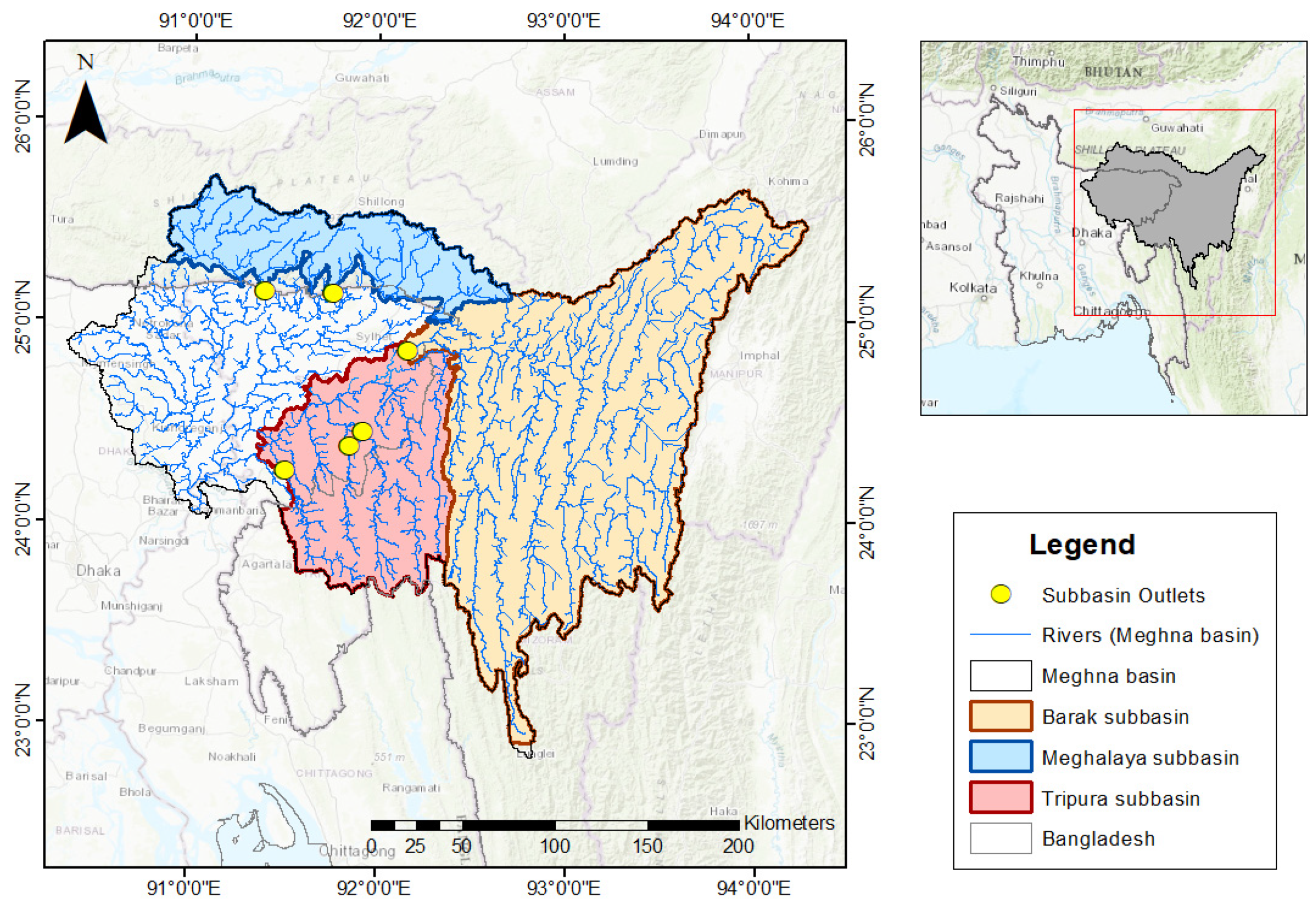
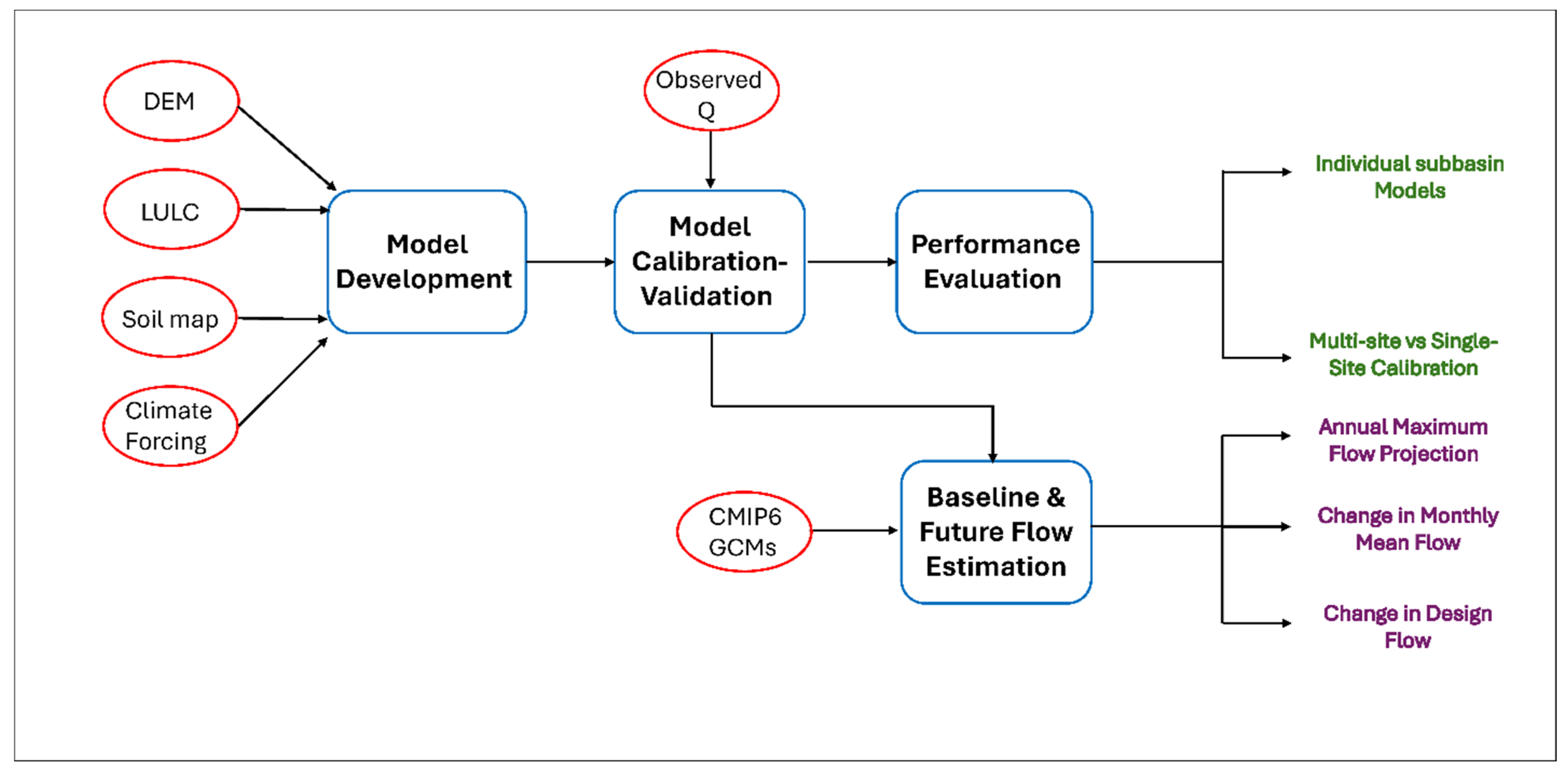
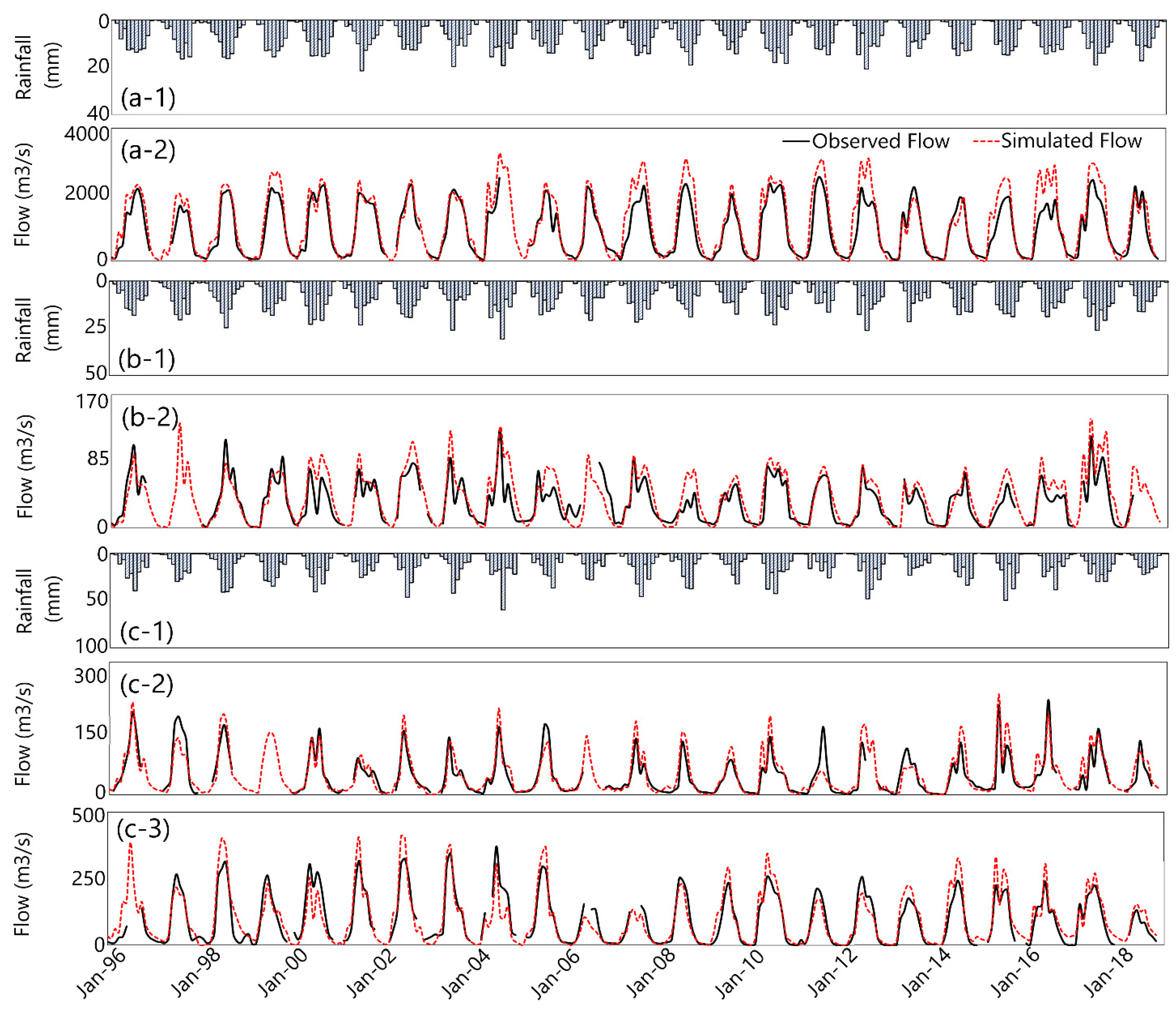
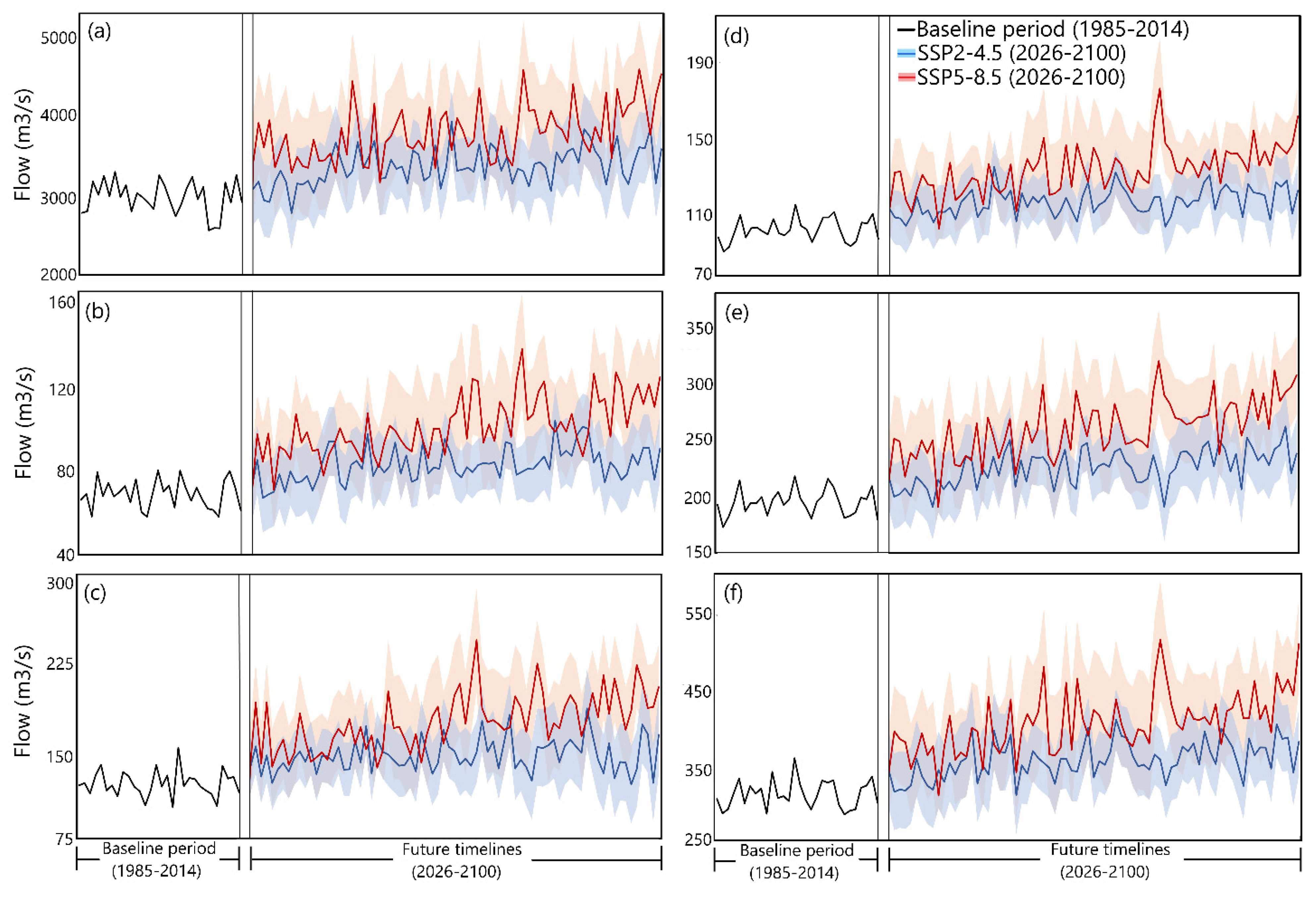
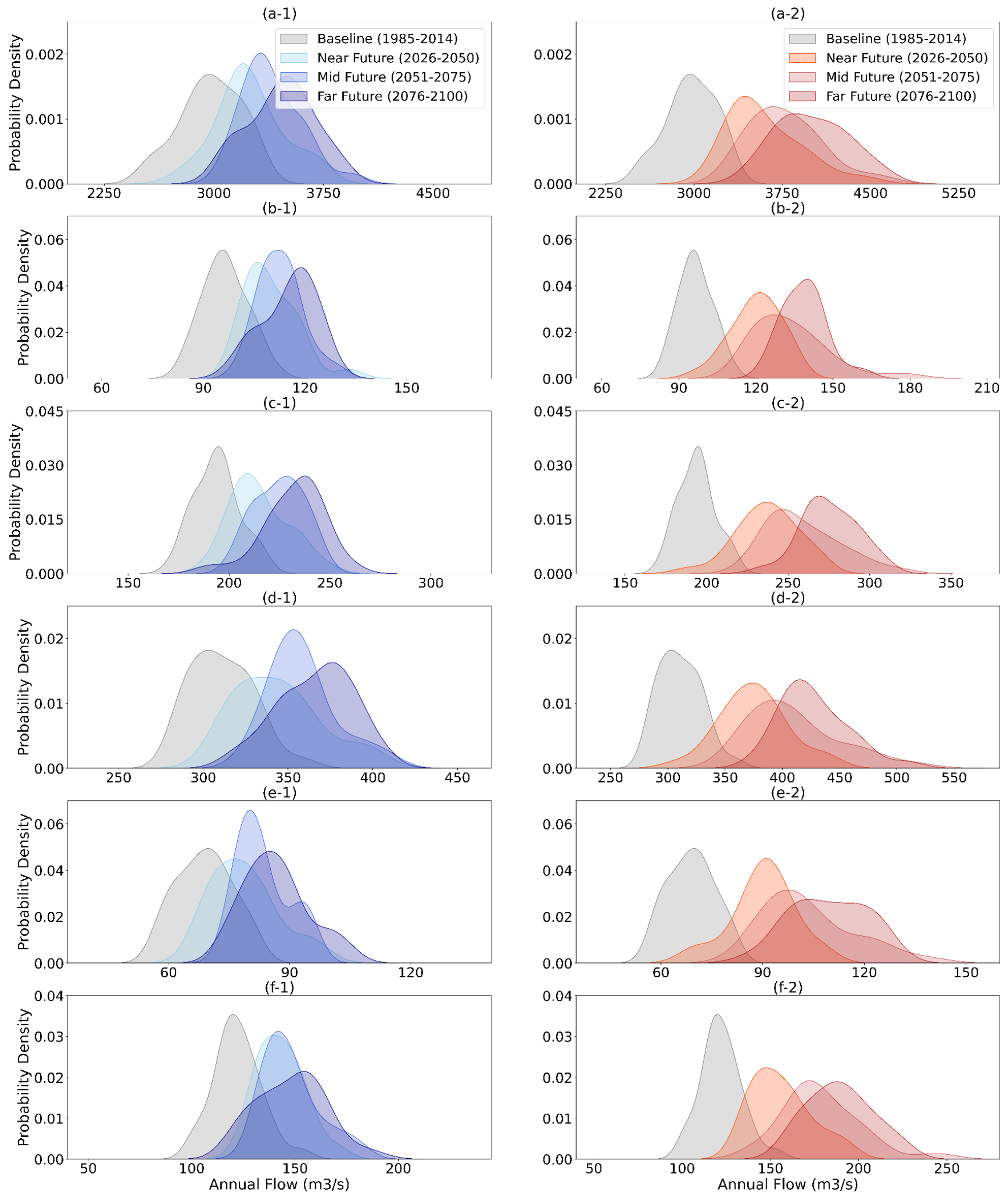


| Basin | Sub-Basin | Calibration | Model/Case Name |
|---|---|---|---|
| Upper Meghna River Basin (UMRB) | Barak | at one location | Barak-01 |
| Tripura | at one location | Tripura-01 | |
| at two locations | Tripura-02 | ||
| at three locations | Tripura-03 | ||
| Meghalaya | at one location | Meghalaya-01 | |
| at two locations | Meghalaya-02 |
| Model Name | Original Resolution (Degree) | Downscaled Resolution (Degree) | Scenarios (SSP) | Country | Institute |
|---|---|---|---|---|---|
| ACCESS-CM2 | 1.25 × 1.875 | 0.25 × 0.25 | SSP2-4.5 SSP5-8.5 | Australia | Centre of Excellence for Climate System Science |
| ACCESS-ESM1-5 | 1.25 × 1.875 | ||||
| BCC-CSM2-MR | 1.1215 × 1.125 | China | Beijing Climate Centre | ||
| CanESM5 | 2.7906 × 2.8125 | Canada | Canadian Centre for Climate Modeling and Analysis | ||
| EC-Earth3 | 0.7018 × 0.703125 | EU | EC-Earth Consortium | ||
| EC-Earth3-Veg | 0.7018 × 0.703125 | ||||
| INM-CM4-8 | 1.5 × 2 | Russia | Institute for Numerical Mathematics | ||
| INM-CM5-0 | 1.5 × 2 | ||||
| MPI-ESM1-2-HR | 0.9351 × 0.9375 | Germany | Max Planck Institute for Meteorology (MPI-M) | ||
| MPI-ESM1-2-LR | 1.8653 × 1.875 | ||||
| MRI-ESM2-0 | 1.1215 × 1.125 | Japan | Meteorological Research Institute | ||
| NorESM2-LM | 1.8947 × 2.5 | Norway | The Norwegian Earth System Model | ||
| NorESM2- MM | 0.9424 × 1.25 |
| Sub-Basins and Model Name | Calibration Location | Calibration (1996–2010) | Validation (2011–2018) | ||||
|---|---|---|---|---|---|---|---|
| R2 | NSE | RSR | R2 | NSE | RSR | ||
| Barak-01 | Sheola | 0.82 | 0.63 | 0.61 | 0.82 | 0.60 | 0.62 |
| Tripura-01 | Kamalganj | 0.76 | 0.72 | 0.62 | 0.91 | 0.86 | 0.38 |
| Tripura-02 | Kamalganj | 0.54 | 0.42 | 0.76 | 0.45 | 0.22 | 0.88 |
| Monu Rly. | 0.56 | 0.48 | 0.72 | 0.42 | 0.24 | 1.12 | |
| Tripura-03 | Kamalganj | 0.67 | 0.60 | 0.63 | 0.85 | 0.67 | 0.57 |
| Monu Rly. | 0.80 | 0.78 | 0.47 | 0.87 | 0.44 | 0.75 | |
| Shaistaganj | 0.83 | 0.65 | 0.59 | 0.68 | 0.06 | 0.97 | |
| Meghalaya-01 | Muslimpur | 0.85 | 0.84 | 0.40 | 0.86 | 0.83 | 0.42 |
| Meghalaya-02 | Muslimpur | 0.85 | 0.83 | 0.41 | 0.84 | 0.81 | 0.44 |
| Islampur | 0.65 | 0.60 | 0.63 | 0.79 | 0.72 | 0.53 | |
| Station Name | Near Future (2026–2050) | Mid-Future (2051–2075) | Far Future (2076–2100) | |||
|---|---|---|---|---|---|---|
| SSP2-4.5 | SSP5-8.5 | SSP2-4.5 | SSP5-8.5 | SSP2-4.5 | SSP5-8.5 | |
| Sheola | 9.05 | 20.83 | 13.96 | 26.87 | 16.18 | 34.37 |
| Kamalganj | 13.88 | 24.58 | 16.88 | 38.30 | 19.50 | 43.81 |
| Monu Rly | 10.61 | 20.62 | 15.23 | 31.91 | 17.73 | 37.39 |
| Shaistaganj | 10.87 | 22.33 | 15.98 | 33.70 | 19.76 | 42.14 |
| Muslimpur | 17.07 | 27.85 | 21.17 | 46.43 | 21.27 | 55.10 |
| Islampur | 14.33 | 30.80 | 20.86 | 50.12 | 25.54 | 58.86 |
| Station Name and ID | Near Future (2026–2050) | Mid-Future (2051–2075) | Far Future (2076–2100) | |||
|---|---|---|---|---|---|---|
| SSP2-4.5 | SSP5-8.5 | SSP2-4.5 | SSP5-8.5 | SSP2-4.5 | SSP5-8.5 | |
| Sheola | 0.52 | 3.46 | 2.54 | 13.85 | 2.97 | 32.00 |
| Kamalganj | 6.00 | 9.60 | 8.37 | 28.04 | 4.84 | 49.53 |
| Monu Rly | 3.42 | 5.22 | 5.46 | 19.96 | 2.99 | 37.92 |
| Shaistaganj | 5.97 | 9.56 | 9.53 | 27.09 | 5.94 | 49.87 |
| Muslimpur | 6.30 | 9.69 | 7.92 | 19.58 | 8.75 | 31.15 |
| Islampur | 6.23 | 9.31 | 9.46 | 22.08 | 11.64 | 39.04 |
| Station Name and ID | Near Future (2026–2050) | Mid-Future (2051–2075) | Far Future (2076–2100) | |||
|---|---|---|---|---|---|---|
| SSP2-4.5 | SSP5-8.5 | SSP2-4.5 | SSP5-8.5 | SSP2-4.5 | SSP5-8.5 | |
| Sheola | 7.75 | 15.64 | 14.41 | 30.40 | 18.09 | 46.98 |
| Kamalganj | 9.56 | 21.02 | 21.38 | 48.02 | 27.75 | 65.95 |
| Monu Rly | 6.89 | 15.64 | 16.44 | 36.82 | 21.14 | 50.53 |
| Shaistaganj | 9.32 | 18.88 | 21.51 | 45.99 | 27.41 | 63.71 |
| Muslimpur | 12.18 | 21.08 | 19.91 | 44.01 | 24.12 | 63.64 |
| Islampur | 11.76 | 19.06 | 19.02 | 40.83 | 23.61 | 60.82 |
| Station Name | DesignFlow at Baseline (m3/s) | Near Future (2026–2050) | Mid-Future (2051–2075) | Far Future (2076–2100) | |||
|---|---|---|---|---|---|---|---|
| SSP2-4.5 | SSP5-8.5 | SSP2-4.5 | SSP5-8.5 | SSP2-4.5 | SSP5-8.5 | ||
| Sheola | 3392.54 | 12.14 | 37.46 | 17.32 | 46.35 | 16.84 | 40.32 |
| Kamalganj | 122.78 | 18.93 | 23.84 | 16.23 | 60.63 | 15.83 | 44.47 |
| Monu Rly | 371.83 | 15.55 | 23.74 | 15.76 | 47.99 | 13.68 | 42.61 |
| Shaistaganj | 222.86 | 14.42 | 24.13 | 13.52 | 46.34 | 15.82 | 41.73 |
| Muslimpur | 152.02 | 14.66 | 35.85 | 25.46 | 61.09 | 24.73 | 55.58 |
| Islampur | 85.05 | 20.11 | 27.92 | 18.99 | 68.47 | 27.35 | 58.25 |
Disclaimer/Publisher’s Note: The statements, opinions and data contained in all publications are solely those of the individual author(s) and contributor(s) and not of MDPI and/or the editor(s). MDPI and/or the editor(s) disclaim responsibility for any injury to people or property resulting from any ideas, methods, instructions or products referred to in the content. |
© 2024 by the authors. Licensee MDPI, Basel, Switzerland. This article is an open access article distributed under the terms and conditions of the Creative Commons Attribution (CC BY) license (https://creativecommons.org/licenses/by/4.0/).
Share and Cite
Mamoon, W.B.; Jahan, N.; Abdullah, F.; Rahman, A. Modeling the Impact of Climate Change on Streamflow in the Meghna River Basin: An Analysis Using SWAT and CMIP6 Scenarios. Water 2024, 16, 1117. https://doi.org/10.3390/w16081117
Mamoon WB, Jahan N, Abdullah F, Rahman A. Modeling the Impact of Climate Change on Streamflow in the Meghna River Basin: An Analysis Using SWAT and CMIP6 Scenarios. Water. 2024; 16(8):1117. https://doi.org/10.3390/w16081117
Chicago/Turabian StyleMamoon, Wasif Bin, Nasreen Jahan, Faruque Abdullah, and Ataur Rahman. 2024. "Modeling the Impact of Climate Change on Streamflow in the Meghna River Basin: An Analysis Using SWAT and CMIP6 Scenarios" Water 16, no. 8: 1117. https://doi.org/10.3390/w16081117
APA StyleMamoon, W. B., Jahan, N., Abdullah, F., & Rahman, A. (2024). Modeling the Impact of Climate Change on Streamflow in the Meghna River Basin: An Analysis Using SWAT and CMIP6 Scenarios. Water, 16(8), 1117. https://doi.org/10.3390/w16081117






